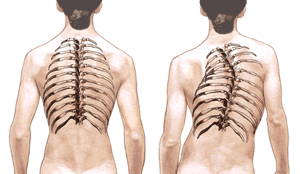
Adult Scoliosis
Scoliosis, or curvature of the spine, is a condition many people associate only with adolescents. But adults can have scoliosis as well. Adult scoliosis is defined as abnormal curvature of the spine in a patient over the age of 18. Sometimes this is the result of a childhood curvature that was left untreated and has since progressed. If scoliosis occurs in an adult with no history of a childhood curvature, it is classified as adult degenerative (de novo) scoliosis.

Symptoms
As we age, many changes occur to our bodies. This is especially true in the spine. When parts of the vertebral column begin to deteriorate, many people begin to experience significant back or neck pain. Common degenerative spinal conditions include:
- Spinal stenosis
- Degenerative disc disease
- Osteoporosis
- Vertebral compression fractures
Any of these conditions can cause the spine to curve to the left or the right. This curvature is not only cosmetically unpleasing, it can also cause other problems such as:
- Trunk imbalance, making the patient appear as though listing to one side
- Spinal instability
- Rib prominence on either side
- Humpback
- Irregular gait caused by a discrepancy in leg length
- Pain
- Difficulty sitting or standing
- Spinal rigidity and stiffness
- Nerve damage
- Cardiopulmonary (heart and lung) problems
Diagnosis
The first, and highly important step, in treating adult degenerative scoliosis, is obviously to make an accurate diagnosis. Dr. Goldstein may use a combination of tools and advanced diagnostic technologies:
- Medical history. We will talk to you about your symptoms, their severity, and the treatments you have already tried. We will be especially interested to know about any history of scoliosis in your family.
- Physical examination. You will be carefully examined for limitation of movement, problems with balance, pain, loss of reflexes in the extremities, muscle weakness, loss of sensation or other signs of neurological damage. You will also be asked to perform a series of range of motion exercises, including bending sideways, backwards and forwards at the waist. The doctor may also measure your legs to see if there is any difference in length.
- Diagnostic tests. Generally, we start with standing x-rays, taken from the front and the side. Side bending and traction x-rays are sometimes used to evaluate spinal flexibility. We may also use a CT scan or MRI to confirm the diagnosis. In some patients we may use a myelogram. This is a test that involves the use of a liquid dye that is injected into the spinal column to show the degree of nerve pinching between involved vertebrae. If curves are identified, your doctor will classify them according to their shape and severity.

Adult Scoliosis
Treatment
Most cases of adult scoliosis are treated using non-surgical methods. These may include:
- Soft tissue therapies
- Pain and anti-inflammatory medications
- Back exercises for posture and strength
- In some cases, bracing may be used (but only to control pain, not to correct the deformity)
Surgical correction of adult degenerative scoliosis is not common. However, it may be necessary under the following conditions:
- When non-operative treatment methods have failed and pain persists
- The curvature is progressive or excessive (curves of over 45 degrees)
- There is evidence of cardiopulmonary (heart and lung) problems caused by the curvature
If surgery is necessary, it may include a fusion combined with spinal instrumentation (the use of rods or screws or other implants to stabilize the spine) of two or more vertebrae. Your surgeon will determine which type of surgery is best for your condition. Be assured that if surgery is necessary, all aspects of the procedure, including risks and benefits, will be fully explained to you ahead of time.
Keep in mind, many cases of adult scoliosis need no treatment at all. A “wait and see” approach may be used to see if the curve progresses over time. In the meantime, it will be important for you to maintain your health by exercising regularly to maintain flexibility and strength, eating right, not smoking, and learning correct body mechanics (posture, the correct way to carry heavy loads, etc.) These are the best ways to prevent further back problems.
